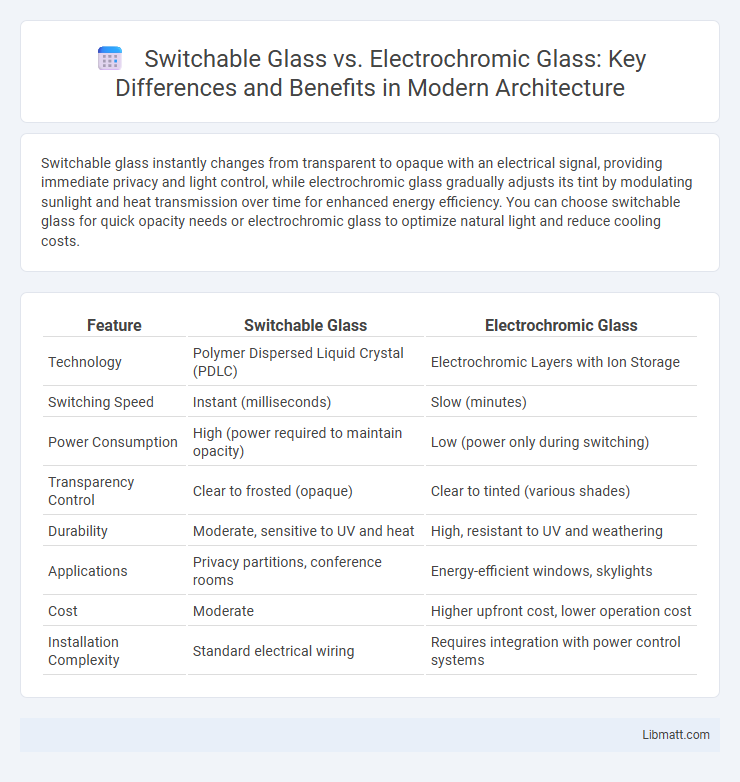Switchable glass instantly changes from transparent to opaque with an electrical signal, providing immediate privacy and light control, while electrochromic glass gradually adjusts its tint by modulating sunlight and heat transmission over time for enhanced energy efficiency. You can choose switchable glass for quick opacity needs or electrochromic glass to optimize natural light and reduce cooling costs.
Table of Comparison
| Feature | Switchable Glass | Electrochromic Glass |
|---|---|---|
| Technology | Polymer Dispersed Liquid Crystal (PDLC) | Electrochromic Layers with Ion Storage |
| Switching Speed | Instant (milliseconds) | Slow (minutes) |
| Power Consumption | High (power required to maintain opacity) | Low (power only during switching) |
| Transparency Control | Clear to frosted (opaque) | Clear to tinted (various shades) |
| Durability | Moderate, sensitive to UV and heat | High, resistant to UV and weathering |
| Applications | Privacy partitions, conference rooms | Energy-efficient windows, skylights |
| Cost | Moderate | Higher upfront cost, lower operation cost |
| Installation Complexity | Standard electrical wiring | Requires integration with power control systems |
Introduction to Smart Glass Technologies
Switchable glass and electrochromic glass are cutting-edge smart glass technologies designed to control light and heat transmission dynamically. Switchable glass typically uses liquid crystal or suspended particle devices to instantly alter transparency with an electrical signal, while electrochromic glass changes tint gradually by applying voltage to an electrochromic layer. Your choice between these technologies depends on factors like response speed, energy efficiency, and desired control over privacy and solar heat gain.
What is Switchable Glass?
Switchable glass, also known as smart glass, is a type of glazing that changes its transparency or opacity when an electric current is applied, offering instant privacy and light control. It utilizes technologies like PDLC (Polymer Dispersed Liquid Crystal) to switch between clear and frosted states, optimizing energy efficiency and visual comfort in residential and commercial spaces. You can control the glass with a simple switch or remote, enhancing your environment without compromising natural light.
Understanding Electrochromic Glass
Electrochromic glass utilizes a thin electrochromic coating that changes opacity when a low-voltage electric current is applied, enabling dynamic control of light and heat transmission. Unlike switchable glass, which relies on liquid crystals or suspended particles to modulate transparency, electrochromic glass offers gradual tinting with energy-efficient performance and long-lasting durability. This technology enhances building energy efficiency by reducing glare and solar heat gain while maintaining natural daylight.
Key Differences Between Switchable and Electrochromic Glass
Switchable glass typically changes from clear to opaque instantly using an electric current, making it ideal for privacy on demand, while electrochromic glass gradually shifts its tint by controlling light transmission through an electrochemical process, enhancing energy efficiency. Switchable glass relies on polymer dispersed liquid crystals (PDLC) technology, providing immediate opacity, whereas electrochromic glass employs solid-state layers to modulate solar heat and glare. Your choice depends on whether you prioritize rapid privacy control or gradual energy-saving light management in architectural or automotive applications.
Performance Comparison: Privacy and Light Control
Switchable glass offers instant privacy by toggling between transparent and opaque states, providing effective light diffusion but limited gradual tint adjustment. Electrochromic glass enables precise control over light transmission with variable tint levels, enhancing energy efficiency and customizable glare reduction while maintaining privacy. Both technologies deliver privacy and light control, but electrochromic glass excels in dynamic modulation and energy savings.
Energy Efficiency and Sustainability
Switchable glass and electrochromic glass both enhance energy efficiency by controlling solar heat gain and reducing reliance on artificial lighting and HVAC systems. Electrochromic glass offers precise, gradual tinting that optimizes natural light and thermal regulation, contributing significantly to sustainability by lowering energy consumption and carbon footprint. You can improve your building's environmental impact and energy performance by selecting the technology that best fits your operational needs and climate conditions.
Installation and Maintenance Requirements
Switchable glass generally requires simpler installation compared to electrochromic glass, as it functions through an embedded polymer dispersed liquid crystal (PDLC) film that activates with electric current, making it compatible with standard glazing units. Maintenance for switchable glass involves minimal upkeep, primarily ensuring electrical connections remain intact to prevent operational failures. Electrochromic glass installation demands integration of more complex control systems and specialized wiring to manage gradual tinting, while its maintenance often includes periodic calibration and potential replacement of electronic components to sustain optimal performance.
Cost Analysis: Upfront and Long-Term Expenses
Switchable glass typically demands higher upfront costs due to complex installation and specialized materials, while electrochromic glass offers a moderate initial investment with potential savings in energy bills over time. Long-term expenses for switchable glass may escalate from maintenance and replacement of control systems, whereas electrochromic glass tends to have lower operational costs through improved energy efficiency and reduced HVAC load. Your choice should weigh the initial budget constraints against projected utility savings and maintenance commitments for optimal cost-effectiveness.
Applications in Residential and Commercial Spaces
Switchable glass and electrochromic glass both enhance privacy and energy efficiency in residential and commercial spaces by allowing dynamic control of light and heat transmission. Switchable glass offers instant opacity changes using an electric current, ideal for conference rooms, bathrooms, and storefronts requiring rapid privacy shifts. Electrochromic glass gradually adjusts tint to reduce glare and solar heat gain, optimizing daylight management in office buildings and smart homes for improved occupant comfort and energy savings.
Choosing the Right Smart Glass for Your Project
Switchable glass offers instant and complete opacity changes ideal for privacy-focused projects, while electrochromic glass provides gradual tint adjustment, optimizing natural light and energy efficiency. Consider project requirements such as response time, level of opacity control, and energy savings when selecting between switchable and electrochromic glass. Budget constraints and maintenance needs also influence the choice, with switchable glass generally requiring more power and electrochromic glass offering longer-term cost benefits.
switchable glass vs electrochromic glass Infographic

 libmatt.com
libmatt.com